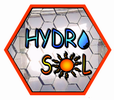
HYDROSOL
Solar Hydrogen via Water Splitting in Advanced Monolithic Reactors for Future Solar Power plants

|
Title of Programme
|
THE FIFTH FRAMEWORK PROGRAMME
ENERGY, ENVIRONMENT AND SUSTAINABLE DEVELOPMENT
Energy Sub-Programme
|
|
Financing Code for Project
|
ÅNK6-CT-2002-00629 |
| Project start year - end year | 2002 - 2005 |
| Financing organisation |
EUROPEAN COMMISSION
RESEARCH DIRECTORATE-GENERAL
|
| Coordinator | Aerosol and Particle Technology Laboratory (APTL) |
| Other partners |
Laboratory of Inorganic Materials CERTH-CPERI (LIM)
Deutsches Zentrum fuer Luft- und Raumfahrt e.V. (DLR)
Johnson Matthey Technology Centre (JM)
|
| Budget / APTL Budget | 2,660,000 € / 686,187 € |
| Scientific Manager / Project researcher |
A. G. Konstandopoulos / S. Lorentzou
|
| Project website | |
| Summary |
The harnessing of the huge energy potential of solar radiation and its effective conversion to chemical fuels such as hydrogen is a subject of primary technological interest. One of the reactions with tremendous economical impact is the dissociation of water to oxygen and hydrogen. The integration of solar energy concentration systems with systems capable to split water is of immense value and impact on the energetics and economics worldwide. However interesting yields can only be achieved at very high temperatures; thus the current state of the art of solar water splitting chemistry is focused on materials that can act as effective water splitters at lower temperatures in a two-step water splitting process. According to this idea, in the first step the redox material (usually the higher-valence-state of a metal oxide) is reduced delivering some of its lattice oxygen; in the second step the reduced material is oxidized by taking oxygen from water and producing hydrogen, according to the following scheme:
 The disadvantage is that a two-step process is required, consisting of a water splitting and a regeneration (oxygen release) step. The advantage is the production of pure hydrogen and the removal of oxygen in separate steps, avoiding the need for high-temperature separation and the chance of explosive mixtures formation. The concept has been proven experimentally for pairs of oxides of multivalent metals or metal/metal oxide systems (e.g. Mn3O4/MnO, Fe3O4/FeO, ZnO/Zn etc.); however even though water splitting is taking place at temperatures lower than 700°C, material regeneration (i.e. reduction) takes place at much higher temperatures (> 1600°C). In addition, despite basic research with respect to active redox pairs, solar reactor concepts have only recently been reported in the literature and are based on particles fed into rotating cavity reactors, concepts that are complicated and costly to operate.
The uniqueness of the HYDROSOL approach is based on the combination of two novel concepts: nanoparticle materials with very high water-splitting activity and regenerability (synthesised by novel routes such as aerosol processes, combustion techniques and reactions under controlled oxygen pressure) and their incorporation as coatings on special refractory ceramic monolithic reactors with high capacity for solar heat absorption. Prior work of the Consortium members has demonstrated that such refractory ceramics can act as solar heat collectors achieving temperatures in excess of 1100 °C; however the concept of combining them with high-temperature water-splitting materials for the exploitation of solar heat in the field of Solar Chemistry has never before been proposed. With this concept, the full cycle can be performed with the water-splitting material immobilized upon the honeycomb walls avoiding the needs of continuous powder feeding and collection from the reactor.Through the HYDROSOL Project, the Consortium team has proposed and developed an innovative solar reactor for the production of hydrogen from the splitting of steam using solar energy. The solar reactor contains no moving parts and is constructed from special refractory ceramic thin-wall, multi-channelled (honeycomb) monoliths optimized to absorb solar radiation and develop sufficiently high temperatures. The monolith channels are coated with an active water-splitting material, and the overall reactor looks very similar to the familiar catalytic converter of modern automobiles. When steam passes through the solar reactor, the active coating material splits water vapor by “trapping” its oxygen and leaving in the effluent gas stream as product pure hydrogen, without any need for expensive and complicated gas separation post-processing steps. In a subsequent step, the oxygen “trapping” material is regenerated (i.e. releases the oxygen absorbed), by increasing the amount of solar heat absorbed by the reactor and hence a cyclic operation is established. Highly active oxygen “trapping”/water-splitting materials (based on doped oxides exhibiting redox behavior) have been synthesized employing different techniques the most active been those produced by aerosol synthesis routes in APTL. A solar reactor based on ceramic refractory honeycomb structures coated with the redox materials above, has been constructed and its capability of achieving uniform temperatures of the order of 1300 °C has been demonstrated.
The evaluation of the redox materials on the solar reactor proved the feasibility of solar hydrogen production by the HYDROSOL process and the stability of the redox/support- assemblies: multi-cyclic solar thermo-chemical splitting of water was successfully demonstrated: the reactor produces hydrogen by cyclic operation exclusively at the expense of solar energy; up to 40 cycles of constant H2 production were operated in a row in a two-day continuous production of hydrogen.
Evaluation of the economic potential of the process and detailed cost analyses indicate that technical improvements provide the potential to reduce the production costs of hydrogen from 24 Eurocent/kWh, to 10 Eurocent/kWh in the long-term.
The developed technology produces hydrogen based on entirely renewable and abundant energy sources and raw materials - solar energy and water respectively – without any CO2 emissions, in an entirely “clean”, natural and environmentally friendly way, addressing thus issues of universal concern and importance. Based on these results, the next efforts involve further scale-up of the technology and its effective coupling with solar concentration systems like solar towers in order to demonstrate large-scale feasibility of a solar plant for the production of solar Hydrogen.
|

